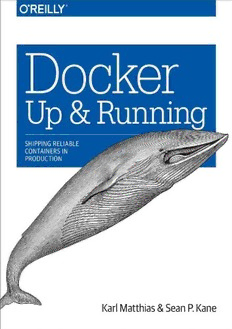
Docker PDF
Preview Docker
Docker: Up and Running Karl Matthias and Sean P. Kane Docker: Up and Running by Karl Matthias and Sean P. Kane Copyright © 2015 Karl Matthias, Sean P. Kane. All rights reserved. Printed in the United States of America. Published by O’Reilly Media, Inc., 1005 Gravenstein Highway North, Sebastopol, CA 95472. O’Reilly books may be purchased for educational, business, or sales promotional use. Online editions are also available for most titles (http://safaribooksonline.com). For more information, contact our corporate/institutional sales department: 800-998-9938 or [email protected]. Editor: Brian Anderson Production Editor: Melanie Yarbrough Copyeditor: Gillian McGarvey Proofreader: Sonia Saruba Indexer: Wendy Catalano Interior Designer: David Futato Cover Designer: Ellie Volkhausen Illustrator: Rebecca Demarest June 2015: First Edition Revision History for the First Edition 2015-06-09: First Release See http://oreilly.com/catalog/errata.csp?isbn=9781491917572 for release details. The O’Reilly logo is a registered trademark of O’Reilly Media, Inc. Docker: Up and Running, the cover image, and related trade dress are trademarks of O’Reilly Media, Inc. While the publisher and the authors have used good faith efforts to ensure that the information and instructions contained in this work are accurate, the publisher and the authors disclaim all responsibility for errors or omissions, including without limitation responsibility for damages resulting from the use of or reliance on this work. Use of the information and instructions contained in this work is at your own risk. If any code samples or other technology this work contains or describes is subject to open source licenses or the intellectual property rights of others, it is your responsibility to ensure that your use thereof complies with such licenses and/or rights. 978-1-491-91757-2 [LSI] Dedication For my wife and children, who make everything worth it. And my parents, who pointed me towards the beautiful intersection between logic and passion. — Sean P. Kane For my Mom, who got me to read, and my Dad, who read to me. And for my wife and daughters, who are my bedrock. — Karl Matthias Foreword “Everything old is new again” is a commonly heard phrase that has described everything from fashion, to politics, to technology. It is also an apt statement when it comes to Linux containers, and I would expand upon it to say, “Everything old is new again — and nonetheless exciting.” Containers have been available for many years in Linux distributions but they’ve seldom been used because of the complexity required to build something that worked. Thus historically, Linux container implementations have been purpose-built with a single objective in mind, which made additional requirements like scaling and portability challenging — if not impossible — to implement. Enter Docker, which has created phenomenal momentum in unlocking the value of Linux containers by combining a standardized packaging format with ease of use, to turn processes that were once esoteric and incomprehensible into consumable capabilities for developers and operations teams. Docker, in a sense, has created a Renaissance for Linux containers, driving an ever-growing wave of interest and possibility, leading to rapid adoption of the technology. It’s helping technology teams everywhere realize the benefits of application portability, simplified integration, and streamlined development as promised by Linux containers for some time but historically trapped behind layers of complexity. Through Docker, Linux containers have catapulted into an elite club of truly disruptive technologies with the power to transform the IT landscape, related ecosystems, and markets. In the wake of this emergence rises a wave of innovation that demonstrates Linux containers’ potential to dramatically change application delivery across a variety of computing environments and platforms while leveraging a spectrum of tehcnical skill sets. Innovation doesn’t necessarily mean the introduction of a completely new, world-altering technology. Like many of its predecessors, Docker’s success stands on the shoulder of giants. It builds on years of technological innovation and Linux evolution that now provides the core capabilities which Docker makes easy to use. The maturity of the Linux capabilities exploited by Docker can now be replicated in other operating systems, allowing Docker to function beyond its Linux roots. Docker is facilitating a disruptive change in the minds of technology professionals. It has reshaped views on which aspects of application development and delivery, as well as infrastructure management should be considered “table stakes” versus complexity that requires technology or process solutions. As is typical for the early adoption phase of any disruptive technology, these perspective changes aim at what’s right in front of us, often oversimplifying and ignoring relevant aspects – but the potential for Docker and Linux containers goes much deeper than simply redefining development. It is redifing the very nature of the application itself. The obvious impact of Docker and the ease of use it brings to Linux containers is the possibility to redefine the organizational divide between business, application development, and IT infrastructure teams. In a sense, Docker provides a tangible
